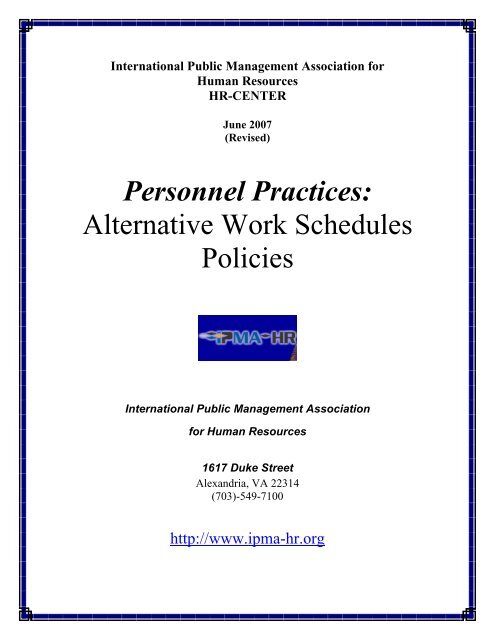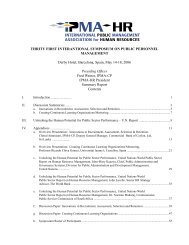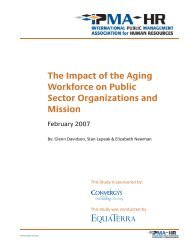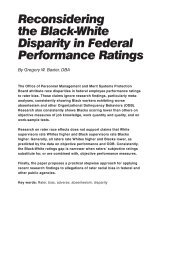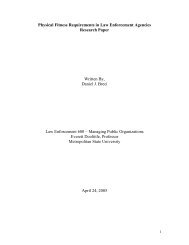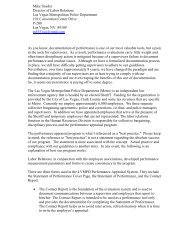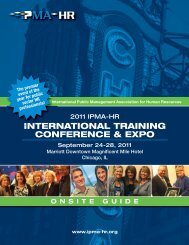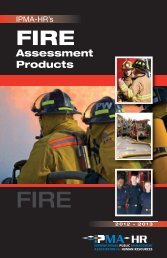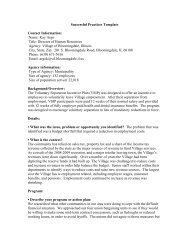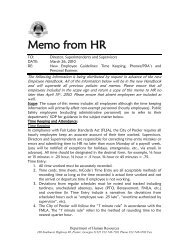Alternative Work Schedules Policies - International Personnel ...
Alternative Work Schedules Policies - International Personnel ...
Alternative Work Schedules Policies - International Personnel ...
Create successful ePaper yourself
Turn your PDF publications into a flip-book with our unique Google optimized e-Paper software.
<strong>International</strong> Public Management Association forHuman ResourcesHR-CENTERJune 2007(Revised)<strong>Personnel</strong> Practices:<strong>Alternative</strong> <strong>Work</strong> <strong>Schedules</strong><strong>Policies</strong><strong>International</strong> Public Management Associationfor Human Resources1617 Duke StreetAlexandria, VA 22314(703)-549-7100http://www.ipma-hr.org
ALTERATIVE WORK SCHEDULES POLICIESTable of ContentsI. Value to <strong>Alternative</strong> <strong>Work</strong> <strong>Schedules</strong>………………………..3II.Sample <strong>Policies</strong>A. City of Austin, TX…...…………………………………………..…..9B. City of Colorado Springs, CO………..…………………..……....…13C. Delaware County, IN………………………………...……………..16D. City of Madison, WI……………………………...………………...19E. National Institute of Environmental Health Sciences (NIEHS)…....22F. State of New Jersey………………...…………………………...…..27G. City of San Jose, CA………………………………………………..30As you develop your own plans and policies, please email information to gov@ipmahr.org.IPMA-HRHR Center1617 Duke StreetAlexandria, VA 22314(703)-549-71002
Is There a value to <strong>Alternative</strong> <strong>Work</strong> <strong>Schedules</strong> in the <strong>Work</strong>placeTodayBy Emayeneme Gbemiye-EttaConflicts between work demands and personal life are now out in the open. It is no longermarginalized as a problem confined to working women with children. It is now recognized asa problem that concerns everyone, from senior executives to administrative assistants, to U.S.Presidents and Secretaries of State.<strong>Alternative</strong> work schedules are flexible work options set up so that full-time and/orpermanent employees can work the hours they are required to work but not in the normaltraditional manner. A flexible work schedule can be a strategic tool when implementedeffectively that leads to more loyal, dedicated and motivated staff. The Bureau of LaborStatistics reported in 2002 that 29 million full-time workers had flexible work schedules.Many believe that alternative work schedules have a positive impact on employeeperformance.There are many advantages to an employee working an alternative work schedule but, for anemployer to institute alternative work schedules, the organization also has to benefit from thearrangement. The obvious benefits are the employers’ ability to accommodate the needs ofhigh performance employees and thus retain those employees. A less obvious benefit is thedecrease in overhead costs since employees may be able to share equipment if their schedulesdo not overlap. There is also the added benefit of being able to respond to customers inanother time zone with those employees on a later work schedule. Community benefits couldinclude less pollution and traffic with fewer cars on the road.There are several types of working schedules that can be considered as being part and parcelof an alternative work schedule. These options are:Flexible Leave <strong>Policies</strong>: Systems that allow accrued sick and annual leave to be combinedfor employees’ use as they choose. <strong>Policies</strong> may include paid or unpaid personal leave time.Parental Leave: Sometimes called “family leave,” a flexible policy that provides time off foreither mothers and/or fathers to care for a newborn or very young children.Flex-Time: <strong>Work</strong> schedules that allow employees to vary their arrival and/or departure timesas long as they work a prescribed number of hours per pay period and are present during adaily “core time” (usually peak business hours).Job Sharing: Two (or more) workers share the duties of one full-time job, each workingpart-time; or two or more workers who have unrelated part-time assignments share the samebudget line.Compressed <strong>Work</strong> Week: A work schedule that enables full-time employees to work theequivalent of a full week in less than 5 days or for employees on biweekly pay schedule towork less than 10 full workdays.Part-Time Employment: Refers to temporary or permanent employees who work a portionof the regular work hours usually on average between 20-30hrs a week. Part-timeemployment has been used for a number of years by both the public and private sectors.3
Telecommuting: Employees can work at home or at a telecommuting worksite and areusually connected to their offices by computer and/or telephone.Phased Retirement: Enables employees to transition gradually from full-time work toretirement with an interim period of part-time work, this period may be used to train areplacement worker.Comp Time – or compensatory time, allows workers to exchange overtime pay for time off,and is a fairly popular idea with both employers and employees. In a poll conducted by theEmployment policy foundation, 81% of women respondents favored comp time as an option.A word of caution in setting up an alternative work schedule, particularly in relation to flextimeschedules and telecommuting arrangements. They are not as trouble free as people maythink. Both of these arrangements are affected by the Fair Labor Standards Act (FLSA),<strong>Work</strong>ers’ Compensation, the Occupational Safety and Health Act, and even antidiscriminationlaws. In setting up any type of <strong>Alternative</strong> <strong>Work</strong> Schedule, an organizationmust remember that the policy must be legitimate, with objective standards spelled out in awritten policy, concerning which positions are open to these arrangements and which are not.After the policy is established, the organization must ensure that the policy does not conflictwith the FLSA. For non-exempt employees, it is ensuring that employees are paid 1 and 1/5times their regular pay for every hour over 40 hours in a one week period. Employers must becareful not to treat exempt employees as hourly when setting up flextime because to someextent exempt employees are already entitled to some flexibility in accomplishing their jobs.<strong>Work</strong>-Life Balance for Employees and EmployersA new concept that encompasses the alternative work schedule is called the <strong>Work</strong> Lifepolicy. The work-life program in a workplace recognizes that people want more options to beable to do what they want to do outside the workplace. It is recognizing diversity and meetingeach employee’s needs. It is also a good way of attracting and retaining the best people.Given that many workers are under stress because of the competing demands of their workand their lives, offering work-life benefits and demonstrating that you have developedstrategies to help employees balance work and life, are ways to gain competitive advantage inthe hiring (and retention) process. The Families and <strong>Work</strong> Institute's Business <strong>Work</strong>-LifeStudy (BWLS) and National Study of the Changing <strong>Work</strong>force (NSCW) found thatemployees with more supportive workplaces as well as better quality jobs are more likelythan other workers to have:• Higher levels of job satisfaction;• More commitment to their companies' success;• Greater loyalty to their companies; and• A stronger intention to remain with their companies.The study also found that employees with more demanding jobs and less supportiveworkplaces experience:• More stress;4
Interestingly, a reasonable balance does not necessarily mean working less.Steps to Develop An <strong>Alternative</strong> <strong>Work</strong> ScheduleDeveloping an alternative work schedule, if your organization does not have a program,requires some planning and cooperation of all employees and supervisors to make sure:(a) The program is implemented in a way that allows all interested employees andsupervisors to participate; and it(b) Does not lead to some employees being perceived as favored above other employees.Several steps can be taken before an alternative work schedule is established in anorganization or department:1. Conduct a needs assessment survey – A needs assessment survey should be conductedamongst employees to determine the interest in this type of program.2. Consider establishing a management-employee committee to help plan the program orservice. This committee then provides a forum for employees to provide input on thedesign features of the program or service.3. Decide which alternative work schedule option(s) will be implemented. A decision onwhat type(s) should be based on the results of the needs assessment survey, the inputof the management employee committee and any other tools that have been used tomake the decision.4. Advertise the selected alternative work schedule. Employees should be made aware ofthe alternative work schedule option(s) being considered and how it will address theirspecific needs. Managers and supervisors should also be made aware of the option(s)and how it will affect personnel decisions in their respective departments.5. Implement necessary policy and administrative changes. Employers should ensure thatappropriate policy changes are made and disseminated throughout the organization.6. Design and establish a reporting mechanism. A reporting mechanism should bedesigned that allows for accurate tracking of hours worked, benefits due, and otheradministrative provisions possibly altered by the establishment of an alternative workschedule. At the same time costs of the program can be tracked to determine its costeffectiveness to the employer.7. When an alternative work schedule is finally agreed upon, any agreements betweenemployees and supervisors should be put in writing so that there is no confusion andany changes in supervisors does not create any problems. Differences in the type ofschedules adopted by individual departments within an organization should also berecorded.6
8. An organization, if not completely comfortable can adopt an option on a small scaleand measure the results before implementing it throughout the organization.Flexible <strong>Work</strong> <strong>Schedules</strong> (Flex-time)Flex-Time is the most commonly known of the alternative work schedule options. Thefederal government began flex-time schedules on an experimental basis in 1979, and it waspermanently authorized by Congress in 1985. The private sector has also adopted the use offlex-time, not only to help employees balance their work and family lives, but for soundbusiness reasons including, better use of equipment and buildings; decreased trafficcongestion; improved attendance, punctuality and productivity among employees.TelecommutingNational survey statistics released by the <strong>International</strong> Telework Association and Council(ITAC) in October 2001, showed that one in five Americans is working away from thetraditional office one or more days per week. According to the ITAC survey, approximately29 million US workers participate in some form of teleworking, either at home (22%), on theroad (24%), in telework centers (8%) or in satellite offices (4%), with 42% indicating thatthey combine working at home with some other form of teleworking. More than two-thirds ofthe teleworkers expressed greater job satisfaction and nearly 80% feel a greater commitmentto their organizations. The biggest barrier to telework is still resistance by middlemanagement. The surveillance type of management style, experts say, hasn’t changed overtime and altering it remains one of telecommuting’s biggest challenges because it runs deepsin some organizations. In getting management to accept telecommuting the HR departmentcan use three basic staffing metrics which tie to work productivity and the bottom line.They are:1. Cost of time and recruitment;2. Rates of retention of valuable employees and;ConclusionAs noted, workers schedules both professional and personal, are becoming more demandingand creating conflict and stress in workers. <strong>Alternative</strong> work schedules are welcomed byemployees as a way to decrease their conflict and stress. There are a fairly large number ofemployers who do not provide the option of flexible work schedules of any kind.Establishing a flexible work schedule provides advantages to both employers and employees,particularly since it can be a great employee retention tool. With planning, mostdisadvantages to establishing an alternative work schedule system can be overcome. Also asindicated, an alternative work schedule can be started on a trial or departmental basis ratherthan organization wide and any glitches worked out before adopting the policy throughoutthe organization.Flextime Resources1. The Bureau of National Affairs, Inc. http://www.bna.com7
2. Catalyst: www.catalystwomen.org3. Ernest and Young – Flexible <strong>Work</strong> Arrangements (FWA)4. Handbook on <strong>Alternative</strong> <strong>Work</strong> <strong>Schedules</strong> – www.opm.gov/oca/AWS/INDEX.HTM5. Independent Women’s Forum – 1-800-224-6000; (703) 558-4991Website: ww.iwf.orgE-mail: info@iwf.org6. Sample Flex-Time Policy: www.womans-work.com/flex-time_policy.htm7. The Alliance of <strong>Work</strong>/Life Professionals: http://awlp.org8. The Boston College Center for <strong>Work</strong> and Family:www.bc.edu/bc_org/avp/csom/executive9. <strong>Work</strong> in America Institute: www.workinamerica.org10. <strong>Work</strong> Trends: Americans’ Attitudes about <strong>Work</strong>. www.heldrich.rutgers.eduTelecommuting Resources1. Research on work/family issues, including flexible work arrangements.www.catalystwomen.org2. University of Pennsylvania Study in Flexible <strong>Work</strong> Arrangements. Sample forms areprovided. www.hr.upenn.edu/quality/worklife/flexopitons/training.htm3. ITAC, the <strong>International</strong> Telework Association & Council. www.telecommute.org4. Resources for those working at home or wanting to work at home.www.Homeworking.com5. Sample Telecommuting agreement: www.workforce.com/telecommuting6. The U.S. Office of <strong>Personnel</strong> Management, telecommuting page.www.opm.gov/wrkfam/telecomm/telecomm.htm8
Cathey Rodgers – City of AustinHuman Resource Department505 Barton Springs Road, Suite 600Austin, TX 78767512 -974-3211City departments may utilize work schedules other than the city’s established businesshours of 8:00 a.m. to 5:00 p.m. to support City transportation and clean air initiatives.Adopting alternative work schedules and telework can contribute significantly toreducing automobile traffic or reducing automobile use at peak travel times, 7:00 a.m. to9:00 a.m. and 4:00 p.m. to 6:00 p.m. Creative work schedules may also enabledepartments to accomplish business needs more effectively, and enhance efforts to recruitand retain employees.According to City of Austin <strong>Personnel</strong> <strong>Policies</strong>, I.C.1. Hours of <strong>Work</strong>, departmentdirectors are responsible for establishing employee work schedules. The policy furtherprovides for use of varying work schedules in stating that, “Individual employees may bedirected to work special hours or shifts as determined by the needs of the department.”The purpose of these guidelines is to provide assistance to departments that areimplementing alternative work schedules, including telework schedules.ALTERNATIVE SCHEDULESFlextime- A 40-hour workweek (for full-time employees) is completed but there isflexibility in establishing daily start and quit times. Days of the workweek may havevarying start and quit times, but the pattern should recur predictably over each workweek.Examples of flextime schedules include:7:00 a.m. to 4:00 p.m. 9:00 a.m. to 6:00 p.m.7:30 a.m. to 4:30 p.m. 9:15 a.m. to 6:15 p.m.7:00 a.m. to 4:00 p.m. (M, W, F) and 9:00 a.m. to 6:00 p.m. (T, TH)NOTE: For safety considerations and to assure the highest quality of performance,supervisors are encouraged to include a meal break of at least 30 minutes in fullwork day schedules.Compressed <strong>Work</strong> Week- An employee completes a 40-hour workweek in less thanfive full workdays.Examples of compressed schedules include:7:00 a.m. to 6:00 p.m. (T through F; four 10-hour days; one-hour meal break)8:30 a.m. to 7:00 p.m. (M,T,Th,F; half-hour meal break)7:00 a.m. to 5:00 p.m. (M through Th, hour meal break); (F- 7:00 a.m. to 11:00 a.m.);*four nine-hour days, one four-hour day9
NOTE: For safety considerations and to assure the highest quality of performance,supervisors are encouraged to include a meal break of at least 30 minutes in fullwork day schedules.*Rotating Days Off- <strong>Schedules</strong> within a work group are designed so that employeeswith same or similar job duties can rotate desirable days off.*Job Sharing- Two employees share the duties of one full-time position. <strong>Work</strong> hours ofeach employee may vary.Telework- <strong>Work</strong> on one or more days each week is completed at home or at an officenear home by substituting telecommunications technology for commuting to the centralwork place. While teleworking, an employee may be assigned a flextime, compressed, orconventional work schedule. Guide lines for telework are found in City of Austin<strong>Personnel</strong> Procedures- Telework (revised June 30, 1999).*Although this schedule may support business needs, it may not necessarily support airquality goals if not planned carefully.RESPONSIBILITIESDepartment directors, managers, and supervisors may consider and approve workschedules based on business needs. Approval of alternative work schedules shouldensure that:• the level and quality of customer service is maintained or increased,• schedules coordinate with needs of internal and external customers,• schedules coordinate effectively with other City departments impacted,• resources are used efficiently and effectively,• operational deadlines are met without increased overtime or comp time accrual,• schedules meet guidelines that support air quality.Managers should continually monitor the effectiveness of work schedules and makeadjustments that are in the best interest of productivity.Employees who work alternative schedules should be accountable for:• completing assigned work,• using work time effectively,• assuring the same or improved level of customer service,• maintaining dependable attendance,• documenting timekeeping accurately, and• communicating work problems and needs to supervisors.ESTABLISHING ALTERNATIVE SCHEDULES10
Options for establishing alternative work schedules rest with each department.Employees within a work group can be invited to suggest work schedules that willaccommodate their personal preferences or family needs while accomplishing workrequirements. Or, the nature of a group’s collective work requirements may naturallysuggest staffing patterns with staggered hours, overlapping schedules, or concentration ofwork on certain days of the week or hours of the day. Individual schedules may besolicited, offered, or directed. However, whether by employee request or by concerteddesign, establishing work schedules should be coordinated within the entire work group,division, or department. Each employee’s schedule should be pre-approved through aprocess established by the department.Part-time, probationary, and temporary employees may also be assigned alternativeschedules at the discretion of the department. <strong>Alternative</strong> work schedules may becancelled or adjusted by management at any time. Reasonable notice to the employeesconcerned will support a positive work environment.Contingency plans should be developed in the event of unplanned short-term and longtermemployee absences, emergencies, and vacations. It may also be necessary to planfor regular or occasional staff meetings.The evaluation and approval process may include having employees complete a requestform. An <strong>Alternative</strong> <strong>Work</strong> Schedule Request Form is attached to these guidelines.However, a department may design its own form.EVALUATING EMPLOYEE REQUESTSSupervisors who evaluate employee requests for alternative work schedules and teleworkshould base a decision to approve or deny the request on objective business reasons. Duecare should be taken to:• coordinate schedules with needs of internal and external customers,• coordinate schedules effectively with other City departments impacted,• provide necessary means of communication between employees and supervisors,• provide for adequate supervision and support of workers on non-traditional shifts,• ensure that criteria for work schedule decisions are consistently applied to employeesin similar circumstances,• comply with overtime provisions of the City of Austin compensation policy,• avoid additional hiring or operational cost.TIMEKEEPING AND PAYROLLContact department human resources staff for assistance in making sure that workschedules comply with time keeping and payroll procedures, City compensation policy,and overtime provisions of the Fair Labor Standards Act. <strong>Work</strong> schedules should recurregularly and be as predictable as possible to conform to overtime rules and avoid payrollerrors. Requests to deviate from an approved schedule should be minimized. Changesshould occur only with supervisor approval.11
Special consideration must be given to City holidays. If an employee is scheduled towork ten hours on an observed eight-hour holiday, he or she must use other accruedleave, i.e., vacation, to be absent for the entire shift. Conversely, if an employee worksten hours on an eight-hour holiday, the employee accrues only eight hours of exceptionvacation leave. If an employee’s regular day off falls on an observed holiday, theemployee will have the holiday hours added to the exception vacation balance or be paidfor that day, as determined by department policy.Another option is to have all alternative schedules revert to eight-hour M-F schedulesduring workweeks that include an observed holiday.Questions regarding time keeping and compensation for employees on alternative workschedules should be directed to the department human resources office.TIMEKEEPING FOR EXEMPT EMPLOYEESThe following questions and answers relate to timekeeping for exempt employeesworking compressed workweeks or flexible schedules.Q. Are there any Banner issues, specifically timekeeping, that would interferewith enabling exempt employees to work flexible schedules or "uneven"weeks across a pay period?A. No, for employees in an FLSA-exempt classification, there are no Banner issuesthat will interfere with an unevenly distributed work cycle.There are also no issues from the Banner system that will affect, edit, or otherwise limit,how many hours are reported for a given day for an exempt employee.Examples of unevenly distributed work cycles:80-hr. biweekly schedule worked as 44 REG in Week-1 and 36 REG in Week-2, or viceversa.80-hr. biweekly schedule worked as 30 REG in Week-1 and 50 REG in Week-2, or viceversa.60-hr. biweekly schedule worked as 25 REG in Week-1 and 35 REG in Week-2, or viceversa.Banner computation of gross pay would not be affectedPHPCALC, Banner's computation of a salaried employee's gross pay, actually arrives atthe pay-period-salary first, and then backs into the hourly pay rate to display on theemployee's pay stubs. The computation is not affected by which week of the biweeklycycle these exempt hours are reported or whether the hours are evenly distributedthroughout the two - week cycle.Hours reporting would not be affected12
Banner's PZAMTIM (time sheet) screen is a biweekly screen, and the timekeeper canshow an exempt employee's time on any combination of days across the pay periodwithout affecting this screen's edits and without having any new edits imposed.Reporting time for a terminating employee would not be affectedOccasionally, some timekeepers make mistakes in reporting time for an exempt employeewho is terminating at a date other than the end of a pay period. None of these final-timesheetissues would be affected (for better or worse) by uneven work schedules for exemptemployees.Q. Are timesheet necessary for exempt employees at all?A. Yes, if they are charging time to more than one labor distribution code or to asingle code other than that which has been saved as their default code inNBAJOBS.MANAGING ALTERNATIVE WORK SCHEDULESHere are some suggestions for transition to alternative schedules:• Start alternative work schedules as a pilot and evaluate results to determine if theyshould continue. This allows for adjustments to be made without employees makinglong-term plans prematurely.• <strong>Work</strong> as a team to develop alternative schedules that maximize success.• Regularly hold group discussions in staff meetings about alternative work schedulesto identify problems and find solutions early on.• Expect an adjustment period for everyone. Employees will not always be availableduring the same hours as the supervisor and coworkers. This may be frustrating tosome. It may be necessary for a workgroup to adapt new systems. The group mayneed to rely more on telephone, voice mail, email, or written messages.• Consider having a system to remind people of new schedules. For example, requireemployees on an alternative work schedule to post their schedules at their office withinstructions to walk-in customers advising where to go for assistance.• Help group members to become familiar with each other’s records and filemanagement system so that case files can be located in an employee’s absence.• Help group members become more familiar with each other’s workload, for backupcoverage when an employee is off duty.Contact the Human Resource Department at 974-3400 for more information orassistance.13
Department of Taxation and various Indiana cities, and varies according to theamount of salary and number of dependency exemptions. Employees are requiredto complete withholding tax certificates upon initial employment and to informthe Human Resource office of any dependency change whenever such changeoccurs.3. Miscellaneous: Examples include garnishments, deferred compensation, childsupport, credit union, employee insurance contributions, etc.4. The Delaware County Auditor may refuse to make deductions, not required by law,which are below certain prescribed minimum amounts, which occur at irregularintervals, or for another similar cause. Other than those deductions required bylaw, the Auditor may decline to make a deduction that the employee's check isinsufficient to cover.5. All requests for payroll deductions must be presented to the Appointing Authorityfor authorization.Section 4.3. <strong>Work</strong> SchedulingSection 4.4. OvertimeA. The Employer shall establish the standard workday, workweek, andstarting and quitting times for each department, taking into accountcurrent and anticipated workloads, public service needs, and other factors.No established schedule shall be construed as a guarantee of work hoursor as a restriction on the Employer's right to restructure the workday orworkweek.B. Subject to the discretion of the Employer, employees may be authorized totake break periods each full working day. Such breaks shall not interferewith the proper performance of the employee's work responsibilities andwill be set by the Appointing Authority and are subject to change.C. Each department's or office's standard workday, workweek, and startingand quitting times shall be appropriately communicated to the affectedemployee(s).A. Any employee may be required to work in excess of the normal workday orworkweek to meet operational demands. Nonexempt employees under the FLSAshall be paid at the rate of one and one-half (11/2) times the employee'sregular hourly rate of pay for all hours worked in excess of forty (40) in anyworkweek, except nonexempt police officers under the FLSA, who shall be paidat the rate of one and one-half (11/2) times the employee's regular hourly rate ofpay for all hours worked in excess of 170 hours in a twenty-eight (28) day workperiod.B. Eligibility for overtime shall be based upon all hours in "active pay status."17
C. Overtime is generally discouraged and is usually performed only when theEmployer determines it is necessary. All overtime must be approved by theemployee's supervisor in advance, except in unusual or emergency situations. Theemployee's supervisor shall closely examine any overtime request not approvedin advance.D. All employees holding employment in more than one (1) position with the Countyshall notify the Department of Human Resources in writing of such jointemployment.E. Each employee who must work overtime shall complete an "OvertimeAuthorization" form and present it to the employee's supervisor for approval. Anyovertime should be discussed and at that time a determination made whetherovertime will be paid in cash or accrued in compensatory time. FLSA allowspublic sector employees to offer "comp" time in lieu of overtime pay. "Comp"time must be used as expeditiously as possible and cannot accumulate more than240 hours before compensation must be made in cash. "Comp" time is wagesearned and must be treated as such. Accrued "comp time" will be paid as wagesupon separation.Section 4.5. Exempt EmployeesA. Salaried employees determined to be exempt from the overtime requirements of the FLSAshall not be eligible for overtime pay as defined herein. Such employees shall not receive areduction in pay for absences of less than one (1) day. However, absences of one (1) full dayor more shall be deducted from the employee's sick leave or vacation leave if the employeehas such leave accumulated.Section 4.6. Flex TimeA. The Employer may utilize "time off" or flexible hours in order to avoid havingemployees work in excess of forty (40) hours in a workweek. Flex-timescheduling must be approved by the department head and/or the AppointingAuthority.18
David Cieslewicz – City of Madison210 Martin Luther King Jr. BlvdRoom 403Madison, WI 53703866 704 2340FROM THE OFFICE OF THE MAYOR ADMINISTRATIVE PROCEDUREMEMORANDUM NO. 2-35SUBJECT: ALTERNATIVE AND FLEXIBLE WORK SCHEDULESDesignation: Division/Department Heads and the Human Resource Director have theauthority to create and approve alternative work schedules and flexible scheduling within theparameters of this policy.Eligibility: This policy is specifically designed for all non-represented, permanent employees.Represented employees may utilize flexible scheduling in accordance with union contractsand Memoranda of Understanding (MOU.)Background: The City of Madison supports management’s role in establishing alternative andflexible work schedules that allow departments and their employees to address the needs ofthe citizens of Madison.As part of providing this flexibility, however, the City of Madison must follow ordinancesand federal laws that regulate work hours on a weekly basis and these should be taken intoaccount when developing alternative and flexible work schedules. (See below)FLSA: The Fair Labor Standards Act (FLSA) defines an employee’s workweek as a fixedand regularly recurring period of 168 hours—7 consecutive 24-hour periods. Additionally itdefines the maximum number of hours an employee can work, without incurring an overtimeobligation, as 40 hours per week.MGO 3.36 (4): Standard Hours per Week / per Day: Per MGO 3.36 (4) “for nonrepresentedfield personnel a standard workweek shall be 40 hours, for non-represented,office personnel the standard hours per week is 38 ¾ hours.” In addition, “standard hours perday for non-represented field personnel shall be 8 hours and for non-represented, officepersonnel 7 ¾ hours.” The MGO also states that the standard number of days per week,during which all non-represented employees shall be on duty, is 5 days.This means that when looking at alternative and flexible work schedules, non-representedfield personnel working more than 40-hours/week, and non-represented office personnelworking more than 38-3/4 hours/week, must be paid overtime or compensatory timeaccording to their grade level. (See MGO 3.38 (11) Overtime Compensation.)Definitions:Flexible <strong>Work</strong> Schedule: Flexible work schedules are changes made to the starting andending times of an employee’s workday.<strong>Alternative</strong> <strong>Work</strong> Schedule (AWS): An alternative work schedule is a pre-scheduled, fixed,continuous schedule of hours that deviates from the standard schedule of an agency.Policy Guidelines: When reviewing requests from non-represented, permanent employees,the following criteria should be considered.Flexible <strong>Work</strong> Schedule: Flexible work schedules always relate to the predetermined coreset of hours when an employee must be present to do the work of an agency.19
Example: Office Core Hours are 8:00 a.m. - 4:30 p.m.Flexible work schedules might include, 7:00 a.m. to 3:30 p.m.; 8:30 a.m. to 5:00 p.m.; 7:30a.m. to 4:00 p.m. MWF and 8:30 a.m. to 5:00 p.m., T/Thur., depending on needs.Flexible scheduling of starting and ending times may be authorized by Department/DivisionHeads to maximize personal, service and production efficiency, remove artificial barriers toemployment, improve employee morale and job satisfaction, as well as provide moreefficient use of energy and transit systems.<strong>Alternative</strong> <strong>Work</strong> Schedule (AWS): As stated above, an AWS is a pre-scheduled, fixed,continuous schedule of hours that deviates from the standard schedule of an agency.<strong>Alternative</strong> work schedules can be created for two reasons:1. To meet a department’s scheduling needs2. To meet the needs of a specific employee.This non-standard hours schedule becomes the employee’s regular schedule.Examples include:• Four, ten-hour days;• Four, nine-hour days and one, four-hour day;• A regular workweek that includes a weekend day.Management has the right to mandate an alternative work schedule for such things asincreasing service efficiency, cost savings, providing for appropriate supervision of workersand declared emergencies.Approval of an alternative work schedule must be obtained from the Department/DivisionHead and the HR Director.Other Criteria:Management must be able to verify the hours worked by an employee.Flexible scheduling must not be detrimental to the City. Items to be considered by theDepartment/ Division Head prior to approval of an alternative or flexible work scheduleinclude:• Budgetary Limitations• Safety Concerns• Liability Issues• Customer Service Requirements• Communication With Co-<strong>Work</strong>ers• Equipment Availability• Access To Support Staff• Undue Administrative Burden20
• Need For Supervision• FLSA ConcernsDepartment/Division Heads have the right to return employees to a standard schedule withreasonable notice.The schedule should not create any additional health, safety or liability concerns for theemployee or the City.The HR Director reviews and resolves intra-departmental disputes on schedules.Procedure:<strong>Alternative</strong> <strong>Work</strong> <strong>Schedules</strong>:To ensure compliance with MGOs, APMs, State and Federal guidelines, alternative workschedules, such as, four, ten-hour days, five-day workweeks that include a weekend day, etc.are approved by Department / Division Heads along with the HR Director.An employee completes an AWS Form and routes it to his or her supervisor for review. TheSupervisor forwards the form to the Department / Division Head and the HR Director forreview and approval. (See attached AWS Form)An AWS Form must also be completed by the Department /Division Head if they decided tocancel or change the alternative work schedule of an employee. This form is forwarded to theHR Director for review and approval.The HR Director reviews and resolves any intra-departmental disputes on schedules.Flexible <strong>Work</strong> <strong>Schedules</strong>:In accordance with MGO 3.36 (4), “the appointing authorities may establish reasonable dailystarting and ending times to meet the needs of their respective departments and divisions.”Division and Department heads can establish daily start and end times for employees in theirarea based on the criteria listed above. No formal paperwork is required.Also, the Department and Division heads may permit employees to work other than standarddaily hours to avoid incurring overtime.21
National Institute of EnvironmentalHealth Sciences (NIEHS)111 Alexander Drive,Research Triangle Park, NC 27709Phone: (919) 541-3345Website: www.niehs.nih.gov/omhrmb/alternat.htmNIEHS ALTERNATIVE WORK SCHEDULESBACKGROUND: For over 30 years there has been a growing interest in non-standard, moreflexible work hours to relieve traffic congestion, improve productivity, expand hours ofservice to the public, and provide greater employment opportunities for those who cannotwork standard fixed work hours. With passage of the Federal Employee Flexible andCompressed <strong>Work</strong> <strong>Schedules</strong> Act of 1978, Federal employees were first granted the authorityto utilize <strong>Alternative</strong> <strong>Work</strong> <strong>Schedules</strong>.In 1980 NIEHS announced its participation in a Flexible <strong>Work</strong> Schedule Program. Theannouncement and guidance for this program consisted of a short memorandum issued by theExecutive Officer. This policy is being updated to conform to current regulations regardingcredit hours.PURPOSE: The purpose of this issuance is twofold. One, since passage of the originallegislation in 1978 there has been a very significant evolution of the <strong>Alternative</strong> <strong>Work</strong><strong>Schedules</strong> Program within the Federal Government. Much of this evolution has resulted inmany more options becoming available to employees. Therefore, our first goal is to makestaff aware of what is currently available. Two, it is important that we move beyond thesimple memorandum from the Executive Officer to a more comprehensive set of guidelinesand procedures. This is being undertaken to enable supervisors and employees to understandtheir roles and responsibilities as we move to an Institute policy, which permits moreflexibility in allowing employees to establish their hours of work.DISCLAIMER: This issuance describes the basics of the flexible and compressed workschedules, jointly referred to as "alternative work schedules" or "AWS," available toemployees of the NIEHS. It also states the basic responsibilities, requirements, andprocedures for administering the AWS at NIEHS. This issuance does not, and is not intendedto, provide guidance on every situation that may arise under an AWS. Additional guidancecan be found in Agency and Departmental issues on the topic of AWS. Of particularimportance is NIH Manual Issuance 2300-610-4 titled " <strong>Alternative</strong> <strong>Work</strong> <strong>Schedules</strong>" datedSeptember 24, 1993. Your Administrative Officer has a supply of that document. The NIHpolicy can be found on the Internet at: http://www1.od.nih.gov/ohrm/issuances/610-4-AWS/Default.htm.COVERAGE: The AWS Program has been established for all full- and part-time civil serviceemployees in the competitive or excepted services. At NIEHS this means all employees inthe following areas are eligible to participate in AWS Programs with the approval of theirsupervisor: General Schedule, Wage Grade, Commissioned Corps, Senior Executive Service,Special Experts, Step (Student Temporary Employment Program), Research Fellows, SeniorResearch Fellows, Visiting Associates and Visiting Scientists. Those NOT eligible toparticipate include: IRTAs, Visiting Fellows, Guest Researchers, Volunteers, andExperts/Consultants. There are two significant exceptions for Commissioned Officers (COs)22
and Senior Executive Service (SES) personnel regarding their participating in AWS. NIHPolicy Manual 2300-610-4 (9/24/93) should be consulted for specifics regarding applicabilityof AWS options to COs and SES personnel.PARTICIPATION: Supervisors are encouraged to provide maximum flexibility for allemployees; however, based on specific job requirements, the same degree of flexibility maynot be available to all employees. Supervisors at each organizational level have the authorityto approve or disapprove NIEHS Alternate <strong>Work</strong> <strong>Schedules</strong> appropriate for theirorganization.OBJECTIVES OF THE ALTERNATIVE WORK SCHEDULE PROGRAM: AWS programsprovide managers and supervisors an alternative methodology for meeting program goalswhile allowing employees to be more flexible in scheduling their activities. Flexibility inwork hours provides employees the opportunity to balance work and family responsibilities,become involved in volunteer activities, and take advantage of educational opportunities, etc.AWS benefits may also be useful for recruitment and retention purposes.NIEHS management supports AWS programs and encourages managers and supervisors toconsider the implementation and continuance of AWS programs when they do not result indiminished levels of service, reductions in productivity, or substantial increases in operatingcosts other than the reasonable administrative costs of establishing the programs.Implementation of AWS is a matter of management and supervisory discretion.SUPERVISORY RESPONSIBILITY: Supervisors are responsible for:• Arranging schedules to ensure adequate coverage within their staff during the 8:30 a.m. -5:00 p.m. period. There will be no overtime or compensatory time granted to provideadequate supervision or coverage.• Planning and organizing assignments during the employee’s approved work hours.• Ensuring proper reporting of hours of work and leave by employees in the ITAS time andattendance system.• Ensuring that employees know whom to contact in case of an emergency.• Requiring work schedule adjustments necessary to accommodate essential work relatedactivities such as meetings, travel, training, conferences, etc. at any time.• Periodically evaluating the impact alternative work schedules have on coverage, service tothe public, and accomplishment of Institute goals.EMPLOYEE RESPONSIBILITY: Flexible work schedules give employees a measure ofpersonal control over their work environment, accompanied by an equal degree ofresponsibility. Full-time employees are expected to be present during core hours onscheduled workdays, and to account for a full 80hour biweekly pay period. Part-timeemployees are expected to account for a prearranged part-time schedule as approved by theirsupervisor. All employees must receive the approval of their supervisor to participate in anyof the available AWS Programs at NIEHS.DEFINITIONS AND REQUIREMENTS:23
• NIEHS Operating Hours: 8:30 a.m. to 5:00 p.m. (Monday through Friday)• Basic <strong>Work</strong> Requirement: The number of non-overtime hours an employee is required towork or account for by leave or otherwise. See attachment A for more details.• Core Hours: 9:30 a.m. to 11:30 a.m. and 1:30 p.m. to 3:30 p.m. Core hours are the hourswhen all full-time employees must be on duty during their scheduled workdays, or in anappropriate leave status.• Flexible Hours: 7:00 a.m. to 9:30 a.m., 11:30 a.m. to 1:30 p.m. and 3:30 p.m. to 6:00 p.m.Flexible hours are those hours of the workday in which the employee has the option torequest approval for arrival and departure times. An employee's work hours may begin asearly as 7:00 a.m. or may end as late as 6:00 p.m.• Credit Hour Bands: Credit hours may be earned only during those hours, which are adjacentto an employee’s scheduled tour of duty. The band in which credit hours may be earnedat NIEHS is as early as 6:00 a.m. and as late as 8:00 p.m.ALTERNATE WORK SCHEDULE AVAILABLE AT NIEHS: Under the umbrella of<strong>Alternative</strong> <strong>Work</strong> <strong>Schedules</strong> there are two basic types of plans. These include thosecommonly referred to as Flexible <strong>Work</strong> <strong>Schedules</strong> (FWS) and those referred to asCompressed <strong>Work</strong> <strong>Schedules</strong> (CWS). At NIEHS there are three options available under FWSand one available under CWS. Each of these is discussed in more detail below:Flexible <strong>Work</strong> <strong>Schedules</strong>:• Flexitour -- Employee picks a tour, which includes 8 hours per day, 40hours a week, and 80hours a pay period. This is the same fixed schedule every day. Technically speaking, 8:30a.m. - 5:00 p.m. could be one of the selected flexitour tours of duty.• Gliding Schedule -- Employee is required to work 8 hours per day, 40hours a week, and 80hours a pay period. However, employees working the gliding work schedule may varytheir arrival and departure time each day. Specifically, they may arrive anytime between7:00 a.m. and 9:30 a.m. and depart 8 1/2 hours after their arrival time.• Variable Day Schedule -- Employee is responsible for working 40 hours in a week and mustbe present during core hours each day or on approved leave. For example, the employeecould work 7 hours on Monday, 9 hours on Tuesday, 8 hours on Wednesday, 10 hours onThursday, and 6 hours on Friday -- a total of 40 hours.Compressed <strong>Work</strong> Schedule (5-4/9): See <strong>Work</strong> Schedule model below for more details.Under the NIEHS Compressed <strong>Work</strong> Schedule, employees work eight 9-hour days and one8-hour day and one day off to effect a 9-day, biweekly work period. The day off during abiweekly work period may be any day as approved by the supervisor. The day off eachbiweekly period shall remain the same unless the employee receives prior supervisoryapproval to change the day. If a supervisor determines that an employee working the 5-4/9CWS must work on their regularly scheduled day off, the employee must be paid overtime orcompensatory time.CREDIT HOURS: Credit hours are any hours in excess of an employee's basic workrequirement that an employee requests to work to vary the length of a succeeding workweekor workday, providing work is available to accomplish. The accumulation and use of credit24
hours must be approved in advance by the employee's supervisor. Credit hours may be earnedand used in increments of one-quarter hour.Full-time employees may carry over a maximum of 24 credit hours from one pay period toanother. Part-time employees may carry over an amount of credit hours equal to one-fourthof their biweekly basic work requirement.As a guide it is suggested that the earning of credit hours be limited to two hours per day.This guide may be exceeded provided the employee obtains their supervisor’s permission inadvance and that work is available to be accomplished. However, based upon the definitionof Credit Hours Bands above, the number of credit hours, which may be earned on a workdayis no more than five. The use of credit hours is not specifically limited, except, the number ofcredit hours used on any day may not exceed the number of hours in the employee’s tour ofduty for that day.There are three limitations associated with the credit hour option:• Credit hours are NOT available to employees utilizing the 5-4/9 Compressed <strong>Work</strong>Schedule.• Credit hours are NOT available to employees who elect not to participate in any form of theAWS program.• Credit hours may not be used before they are earned.OVERTIME, HOLIDAY, AND COMPENSATORY TIME: Overtime, holiday, andcompensatory time provisions have not changed except for employees working the 5-4/9CWS. For employee working the 5-4/9 CWS, when a holiday or "in-lieu of holiday" falls onthe employees regularly scheduled day off the employee’s day off remains the same. Holidaypay will be granted for the day before or day after the regularly scheduled day off inaccordance with the NIH Policy Manual 2300-610-4, dated 9/24/93, p. 17. Holiday pay willbe granted for the number of hours the employees is regularly scheduled to work on the dayon which the holidayfalls. For example, employees working the 5-4/9 CWS will be paid for 9hours when "their" holiday falls on one of their regularly scheduled 9hour workdays.If an employee is required by management to work hours that are in excess of the basic workrequirement, such hours are not credit hours. These hours must be paid as overtime accordingto the premium pay provisions of Title 5 and Title 38 of the United States Code and theovertime provisions of the Fair Labor Standards Act. However, an employee who is eligibleto earn credit hours may choose to earn credit hours in lieu of overtime.PROCEDURES FOR IMPLEMENTING AWS PROGRAMS AT NIEHS: Employeesmay not be directed to participate in the AWS Program.Copies of the approved plan, approved tours of duty, approved exceptions, furtherimplementing instructions and training will be provided to supervisors, timekeepers andemployees.Organizations using AWS programs must maintain and provide data to the ICD ApprovingOfficial, the Associate Director for Management, that assesses the impact of AWS Programson productivity, service to the public, costs, etc. within their organization.ALTERNATE WORK SCHEDULE PROGRAM TERMINATION: An employee’sAWS should be modified or terminated if necessary, should he/she require closer supervisionthan is generally available or develops performance or conduct problems. These employeesshould be precluded from participating under an AWS until there is no longer a need forcloser supervision or until the deficiency is corrected.25
TIME AND ATTENDANCE REPORTING: An accurate account of the varied workinghours of participants must be maintained. Whether participating in the Flexible <strong>Work</strong>Schedule program or not, each NIEHS employee will document arrival and departure timeseach day using the ITAS time and attendance system. Regardless of what system is used, thesupervisor who certifies time and attendance must have affirmative or personal knowledge ofthe employees' entitlement to pay by showing the number of hours of duty, attendance, andnature and length of absences.LUNCH PERIODS: Lunch periods remain the same under AWS. Employees may not savelunch-time in order to leave early.LEAVE USAGE: Flexible work hours provide employees the opportunity to schedule theirtime off to make better use of annual and sick leave. This enables employees to conserve sickleave for use in case of a major illness. It is not required for employees to use the flexibletime periods for doctor or dental appointments or other personal matters. Employees have theright to request annual, sick or other appropriate leave during core or flexible hours asneeded.Supervisors retain the authority to approve requests for leave in advance; therefore,employees should continue submitting leave requests in advance. Time off using credit hoursmust also be requested in advance.When employees working the 5-4/9 CWS are absent an entire day they are required to takeappropriate leave to cover the number of hours they were scheduled to work on that day. Forexample, if an employee requests leave on a regularly scheduled 9 hour workday theemployee will be required to use 9 hours sick, annual or other appropriate leave.DOCUMENTING THE TOUR OF DUTY: Each employee requesting an AWS mustdocument their tour of duty, in writing and acquire supervisory approval. It can bedocumented by memorandum or other suitable document. The supervisor must provide acopy of the approved tour of duty, in writing to each employee's timekeeper.OPEN SEASON: The first weeks of January and July each year will be "open seasons" foremployees to request a change in their previously approved work schedule. Supervisors havethe authority to make necessary changes any time, as needed. Employees requesting anemergency change for any length of time, must acquire prior supervisory approval. Approvedchanges become effective the beginning of the following pay period.PROGRAM EVALUATION: An AWS evaluation must be conducted during orimmediately after the first year implementation and every 5 years after implementation.Assessments must focus on productivity, service to the public, costs, etc.RECORDS RETENTION AND DISPOSAL: Records pertaining to AWS are retained anddisposed of under the authority of NIH Manual 1743 "Keeping and Destroying Records,"Appendix 1, NIH Records Control Schedule", Item 1100-M-1-b as follows:• ICs - Retain AWS plans and approved employee request for tours of duty as long as theyare accurate, i.e. reflect the current situation. Destroy the records two years after theretention period ends.• DPS - Retains IC AWS plans for as long as they are needed for administrative purposes.Destroys the IC plans and all related information two years after they are no longerneeded.26
Warren BarclayChief, Research ProjectsNew Jersey Department of<strong>Personnel</strong>PO Box 319, Trenton, NJ 08625Phone: (609) 777-0933E-mail: barclay@dop.state.nj.usState of New JerseyNEW JERSEY ADMINISTRATIVE CODETITLE 4A. DEPARTMENT OF PERSONNELCHAPTER 6. LEAVES, HOURS OF WORK AND EMPLOYEE DEVELOPMENTSUBCHAPTER 2. HOURS OF WORKCurrent through December 17, 2001; 33 N.J. Reg. No. 24.4A: 6-2.6 Flexitime programs: State service(a) Appointing authorities may establish flexitime programs to accommodate operationaland/or employee needs, and shall provide for:1. Core time, which is the period of time during which all employees must be present;2. Flexible time, which is the period of time before and after the core time in whichthe employees may choose, subject to appointing authority approval, time ofarrival and departure;3. A meal period, which may be flexible in duration and scheduling.(b) An appointing authority may limit participation in a flexitime program to selected groupsof job titles, work units and/or work locations to accommodate operational needs.(c) Department of <strong>Personnel</strong> assigned workweeks for affected titles, for example, 35 or 40hours, shall be retained.(d) Establishment, modification or termination of a flexitime program shall not becomeeffective without the approval of the Commissioner. Requests for these actions shall besubmitted at least 30 days in advance of the proposed effective date to the Department of<strong>Personnel</strong> and shall include:1. Justification which relates the requested action to operational and employee needs;2. Statement of impact on services to the public or agency clientele;3. Details of the core time, flexible time and meal periods;4. Groups of job titles, work units and/or work locations to be covered by theprogram;5. Procedures governing employee participation in the program;27
6. Approval procedures for individual flexitime schedules and changes;7. Provisions for giving employees at least two weeks notice of termination of theprogram;8. Monitoring and evaluation procedures; and9. Name, address and telephone number of the program administrator.(e) An appointing authority may authorize a complete or partial temporary suspension of theflexitime program if required by operational needs. Within 10 days of the suspension of theprogram, the appointing authority shall submit to the Commissioner a fully detailedjustification and specify the duration of the suspension.(f) Appointing authorities should consult with affected negotiations representativesconcerning flexitime programs before implementation.(g) A description of an appointing authority's flexitime program shall be made available toemployees upon request.(h) Overtime compensation for employees in flexitime programs shall be regulated in thesame manner as for all other employees.4A: 6-2.7 <strong>Alternative</strong> workweek programs: State service(a) Appointing authorities may establish alternative workweek programs, such as a four dayworkweek, to accommodate operational and/or employee needs.(b) A program may be developed for year-round use or for a specific portion of a year.(c) An appointing authority may limit participation in an alternative workweek program toselected groups of job titles, work units and/or work locations to accommodate operationalneeds.(d) Department of <strong>Personnel</strong> assigned workweeks for affected titles, for example, 35 or 40hours, shall be retained.(e) Appointing authorities shall develop, subject to Department of <strong>Personnel</strong> approval,appropriate sick, vacation and administrative leave schedules for employees participating inan alternative workweek program.(f) Since employees in an alternative workweek program have a longer or shorter workdaythan employees on a five day workweek schedule, a time differential exists on holidays. Thisdifferential shall be equalized in a manner determined by the appointing authority. If aholiday occurs on an employee's regular day off, he or she shall be granted an additional dayoff consistent with operational needs.(g) Establishment, modification or termination of an alternative workweek program shall notbecome effective without the approval of the Commissioner. Requests for these actions mustbe submitted at least 30 days in advance of the proposed effective date to the Department of<strong>Personnel</strong> and shall include the same items listed in N.J.A.C. 4A: 6-2.6(d).(h) An appointing authority may authorize a complete or partial temporary suspension of thealternative workweek program if required by operational needs. Within 10 days of thesuspension of the program, the appointing authority shall submit to the Commissioner a fullydetailed justification and specify the duration of the suspension.(i) Appointing authorities should consult with affected negotiations representativesconcerning alternative workweek programs before implementation.28
(j) A description of an appointing authority's alternative workweek program shall be madeavailable to employees upon request.(k) Overtime compensation for employees in alternative workweek programs shall beregulated in the same manner as for all other employees, except as specified in N.J.A.C.4A:3-5.3.Amended by R.1997 d.8, effective January 6, 1997.See: 28 N.J.R. 4295(b), 29 N.J.R. 123(b).In (e), inserted reference to Department of <strong>Personnel</strong> approval; deleted (e)1 and (e)2, relatingto four day workweek employees; and, in (k), added reference to exception.4A: 6-2.8 Adjusted hours of operation: State service(a) Appointing authorities may adjust established hours of daily or shift operations toaccommodate operational and/or employee needs.(b) Department of <strong>Personnel</strong> assigned workweeks, for affected titles, for example, 35 or 40hours, shall be retained.(c) Except for emergency situations of limited duration, adjustments in hours of daily or shiftoperation shall not become effective without the approval of the Commissioner. Requests forthese actions should be submitted at least 30 days in advance of the proposed effective date tothe Department of <strong>Personnel</strong> and shall include:1. Justification which relates the change to operational and employee needs;2. Statement of impact on services to the public or agency clientele, employees and thecommunity, that is, traffic flow;3. Details of adjustments;4. <strong>Work</strong> locations and approximate number of employees affected;5. Provisions for giving employees at least two weeks written notice of adjustments; and6. Name, address and telephone number of the program administrator.(d) Appointing authorities should consult with affected negotiations representatives regardingadjustments in hours of daily or shift operations before implementation.29
Human Resources – City of San Jose200 East Santa Clara St.San Jose, CA 95113408 535 1285ARTICLE 26 PROBATIONARY PERIOD26.1 Probationary periods shall not be less than six (6) or twelve (12) months of actualservice as determined by the Civil Service Commission. Actual service shallmean regular hours worked, paid holidays and up to 80 hours of othercumulative or consecutive paid or unpaid absences.26.2 An employee's probationary period may be extended at the discretion of the City upto a maximum of three (3) months of actual and continuous service. The employeewill be notified in writing of the length and reason of the extension. The employeewill be provided with a copy of their performance appraisal and a copy of the memofrom the department to Human Resources which outlines the reasons for the requestfor extension.ARTICLE 27 ALTERNATE DISCIPLINEAs an alternative to suspension, demotion or dismissal, the appointing authority mayreduce an employee's salary step up to no more than two steps in a case involving a lossof driving privileges or attendance problems (excluding authorized paid sick leave). Theamount and length of time of the salary reduction will be specified in the Notice ofIntended Discipline. The salary may be reduced either for a specified period of time oruntil the condition which caused the salary reduction has been corrected; e.g.,reinstatement of city driving privileges. The employee may appeal this action, includingthe amount and the length of time, to the Civil Service Commission according to thesame rules as apply to other formal disciplinary appeals. Reduction of salary step maycontinue to be used for voluntary settlement agreements.ARTICLE 28 ALTERNATIVE WORK SCHEDULE28.1 The City and the Union agree that the availability of <strong>Alternative</strong> <strong>Work</strong> <strong>Schedules</strong> isa valuable benefit to employees in that it promotes job satisfaction, and is of benefit tothe city in that it reduces traffic congestion and demands on limited parking facilities.The use of alternate schedules is encouraged, where it can be accommodated withoutimpairing departmental operations or public service.28.2 As an alternative to the normal work schedule assigned by the department inaccordance with Article 6.3, and subject to the concurrence and approval of respectiveDepartment Heads and the City Manager, a regular full-time employee may elect to workan alternative work schedule. The following conditions and restrictions apply to allemployees electing an alternative schedule.28.2.1 An employee may elect to establish a biweekly work schedule which varies fromthe normal schedule in the number of hours worked per day and in the number of daysworked per week, except that no single workday may exceed ten (10) hours and total30
scheduled biweekly hours are not to exceed eighty (80) hours. Unless otherwise specifiedin this Memorandum of Agreement, alternate schedules shall not include paid lunchperiods. The employee may elect a different schedule for each calendar week within abiweekly period. Examples of schedules that may be elected include:• Four 10-hour days each week (4/10’s)• Four 9-hour days and one 4-hour day each week (9/80’s)• Eight 9-hour days, one 8-hour day, and one day off each pay period28.2.2 No alternate work schedule may be established in which overtime is incurred as apart of the established work schedule either under this agreement or under Federal orState law.28.2.3 The alternate schedule is designed to accommodate the needs of the employee andthe work unit. Once elected and approved, it is intended to continue for an indefiniteperiod. However, should the needs of the employee or work unit dictate, the alternateschedule may be terminated with reasonable notice.28.2.4 It is further understood that any alternate schedule agreement entered into pursuantto the provisions herein, shall terminate immediately upon the date of the transfer,promotion, or demotion of the employee.28.2.5 For a schedule of four 10-hour days, the three (3) consecutive days off may bewaived by mutual agreement.28.3 Holidays and Other Paid Leave for Alternate <strong>Schedules</strong>The following provisions for holiday and other paid leave shall apply to employees on analternate work schedule.28.3.1 If an employee takes paid leave (e.g., holiday, sick leave, vacation, compensatorytime off, jury duty, bereavement leave, personal leave, etc.) on a scheduled work day,he/she shall be entitled to pay for the number of hours he/she was scheduled to work thatday.28.3.2 If a holiday is observed on an employee's day off, he/she shall be credited witheight (8) hours compensatory time off at the 1.0 rate for a full day holiday. The exceptionto this policy is stated in section 28.4, below.28.3.3 If an employee on an alternate schedule works on a holiday, the employee shallreceive eight (8) hours of compensatory time at the 1.0 rate for a full day holiday and inaddition shall receive pay or compensatory time off at the 1.5 rate for the number ofhours actually worked.28.4 For employees who were placed on an alternate work schedule prior to November 1,1993, if any of said holidays falls on a full-time employee's regular day off, during whichhe/she is not required to work, such employee shall be entitled to compensatory time offduty equal to the number of regularly scheduled hours which the employee works duringhis or her assigned work day.28.5 Any employee who begins an alternative work schedule after November 1, 1993,will be compensated for holidays according to the provisions of Article 28.3.31


